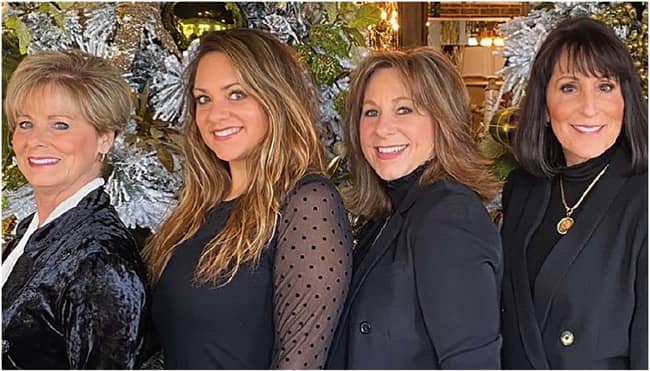
Content about HFA member-retailers contributed by HFA.

Carolyn Blum, second from right, and associates from HFA member B. de Vine. Blum, whose Houston, Texas, store offers high-end furniture and interior design services, says the pandemic has not slowed down business. “We’re blowing and going,” she said.
|
Tucked in between other stores, B. de Vine looks like every other retailer in Vintage Park, a 350,000-square-foot outdoor shopping center in Houston.
People were lined up at the door to buy them, Stephanie Angold, owner of the furniture and home décor store, said.
There is, however, one striking difference between this furniture store and its neighbors. B. de Vine is the store with cars parked out front, shoppers inside, and sales climbing week after week. In a city whose economy has gone ice cold, B. de Vine is a rare hot spot.
Home Furnishings Association member Carolyn Blum said she’d like to take credit for that surge in sales—business has doubled the past two months compared to last year—but she knows better. B. de Vine sells high-end furniture, lines like Paul Roberts and John Richards atop $3,500 Jaipur rugs. It’s not out of the ordinary for a B. de Vine customer from The Woodlands, Tomball, Magnolia, Cypress or Houston’s surrounding upscale communities to walk out with a new six-figure living room.
“This is our time—we’re blowing and going,” said Blum, walking the showroom hallways last month at Las Vegas Market, a week before the market’s official start. “Our customers haven’t felt the effects of the economy like some have, so we’re very fortunate in that way.”
The secret to B. de Vine’s success isn’t really a secret at all. While demand, tightening credit and the worst unemployment levels in decades have altered consumer spending habits, there remains a slice of the workforce that has not felt the recession’s pain—yet.
It’s easy to go down in price and quality, very much another story to go up,” Epperson said. If you’re a retailer known for $499 sofas, that’s good. That means you’re known for something, so stay with it.
|
Blum said her business suffered when Texas and the rest of the nation shut down most brick-and-mortar retail operations. “But my customers were still there, and we were still needed for our design services,” said Blum. “That never went away, and I just don’t think it will.”
Blum opened her furniture store in 2014—six years after the Great Recession. The current recession is the only economic speed bump her business has faced.
ndustry analyst Jerry Epperson said Blum’s story is similar to other high-end furniture retailers. “I think back in March when the stock market dropped like a stone, their business dropped, too, because, their clients’ assets went down,” said Epperson. “But look at what happened through mid-September this year. The market kept going up. That meant that the folks who shopped high-end had confidence.”
Epperson said retailers should not look at Blum’s booming business and assume they can replicate that success simply by upgrading the furniture lines they sell.
“It’s easy to go down in price and quality, very much another story to go up,” Epperson said. “If you’re a retailer known for $499 sofas, that’s good. That means you’re known for something, so stay with it.”
Samsen Furniture
HFA member Doug Samsen of Genoa, Ohio, is trying to buck that trend. Samsen spent the past five years as an Art Van franchisee until the company filed for bankruptcy earlier this year. Samsen Furniture, as the store is now called, is going back to the independent name it carried back when the store opened 60 years ago.

And with the new name, Samsen wants to sell higher-end lines of furniture than were offered under the Art Van brand. He’s working with La-Z-Boy, England, Flexsteel, Liberty and other manufacturers. That’s not easy these days given tight supply lines and exclusivity rights, but Samsen is being patient. "We are filling our showroom with what we can until we can find the right lines,” he said.
Epperson, a regular speaker at the HFA’s Resource Center, said furniture retailers considering adding a higher line to their showrooms should start slowly. “Take a section at the front of your showroom and dedicate it to higher end,” he said. “Call it a ‘boutique’ and let people know it’s a little different than everything else you sell. In three months, you’ll know if you’re on to something or not.”
About HFA: The Home Furnishings Association is the only trade association dedicated to the success of furniture retailers. For more information on HFA
membership and services for home furnishings retailers visit https://myhfa.org or call 800.422.3778
A feature about Home Furnishings Association's retail members, legislation affecting the furniture industry and other retail news from HFA.